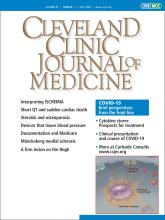
Although it seems like forever, we are only months into the COVID-19 pandemic, so it should really be no surprise that there are huge gaps in our understanding of the infection and its treatment. It took decades before we developed effective therapies for HIV, hepatitis B, and non-A non-B hepatitis. But this is different. It feels different. It was on us like a tidal wave, and we are now inundated with new data 24/7. Clinical descriptions of new syndromes linked to coronavirus infection and results of small randomized and larger observational studies appear online ahead of print, and alerts are forwarded to our inboxes in a constant stream, not to mention what we hear in the nightly news. Every medical center seems to be scrambling to conduct emergent clinical trials comparing novel treatments with “usual care,” but “usual care” of COVID-19 patients is also changing at a rapid pace.
With all this information, it seems we should know more than we do about how to manage the very sick. But it even in a pandemic affecting such a large number of patients in a short window of time, with many of them experiencing measurable outcome events, well-done randomized treatment trials take time to orchestrate and complete. When morbidity and mortality of hospitalized patients is high, with no known effective therapy, the usual care of patients will likely include multiple unproven medications in an attempt to turn the tide of their infection. This can dramatically complicate the analysis of observational studies. Plus, this virus drives a complicated pathobiology.
The clinical expression and course of COVID-19 are pleomorphic and, thus far, are not easily predicted. There are asymptomatic infected individuals who are nonetheless shedding virus, and presymptomatic individuals seemingly even more infective. Most patients experience a mild to modest illness with some combination of fatigue, gastrointestinal symptoms, anosmia, and respiratory symptoms. But some, perhaps after 5 to 10 days, have a second phase of illness characterized by markedly worsened respiratory symptoms due to severe and progressive viral pneumonia. And within this latter group, some experience a dramatic clinical downturn with variable cardiopulmonary collapse, high fevers, and hypercoagulability associated with laboratory markers consistent with what has been called cytokine storm, macrophage activation syndrome (MAS), or in some other settings, hemophagocytic lymphohistocytosis (HLH). The similarity to these latter syndromes, which often respond to agents directed against the cytokines interleukin 1 (IL-1) (anakinra, canakinumab) or interleukin 6 (IL-6) (tocilizumab, sarilumab), has led to empiric use of these agents and to the initiation of multiple formal clinical trials, as discussed by Dr. Len Calabrese in this issue of the Journal (page 389).
But it is not as simple as patients experiencing cytokine storm just having worse disease, characterized by immune overreactivity, which needs to be quelled by blocking the culprit immune hormone. The primary culprit contributing to the progressive lung dysfunction and damage is not certain. Is it all immune damage? Or is the continued persistence of coronavirus playing a direct or indirect role through continued activation of primordial components of the immune system? And is the hyperinflammatory response the body’s last-ditch effort at controlling the virus, in which case blocking it might (in the absence of an effective antiviral therapy) be counterproductive? Hence the need for well-done, controlled, and randomized clinical trials.
The respective significance of active viral infection and replication vs effects of ultra-high levels of inflammatory mediators (IL-1, IL-6, granulocyte-macrophage colony-stimulating factor) on lung damage and multisystem failure remains to be delineated. Elevated levels of IL-6 and downstream markers of cytokine effects (eg, ferritin) have been associated with death, but this association doesn’t prove that it is not the persistence of viral replication and viral products that are in fact contributing to the ongoing elaboration of these cytokines as well as to direct damage to lung tissue.
The biology is complicated. This novel coronavirus has been shown to increase synthesis of IL-1 by stimulating its precursor pro-IL-1 as well as activating the intracellular inflammasome cascade that cleaves active IL-1 from its precursor. Additionally, there are studies that indicate the virus can antagonize the initial host antiviral mechanisms involving interferon generation and natural killer cell-mediated destruction of viral infected cells, resulting in persistence of replicating virus. This latter effect can mimic the rare genetically influenced primary HLH syndromes. Thus, blocking specific cytokines may not be sufficient therapy, unless the virus itself can also be eliminated.
Adding to this complexity, there are studies demonstrating that IL-6 can play an important antiviral role and also can be a positive influence on repair and remodeling following experimental inflammatory lung injury induced in animals by endotoxin or bleomycin.
A lack of an answer to how best to treat patients with severe COVID-19 is not the same as having a lack of information. The latter continues to grow, the former will hopefully follow. Certainly, identifying a potent antiviral agent will help enormously, and I’d expect an antiviral will work synergistically with anticytokine strategies in patients with severe disease. In the meantime, we await clinical results and biochemical analyses from the several prospective trials under way, while wading through the minefields of many well-intentioned but compromised, complicated, and hard-to-interpret observational studies.
If after reading the Calabrese article you are interested in reading more about the fascinating biology of the immune response to this virus that is so rapidly unfolding, I refer you to 2 other well-referenced reviews,1,2 and more articles about COVID-19 in general are available at our COVID-19 Curbside Consults section at www.ccjm.org.
- Copyright © 2020 The Cleveland Clinic Foundation. All Rights Reserved.






